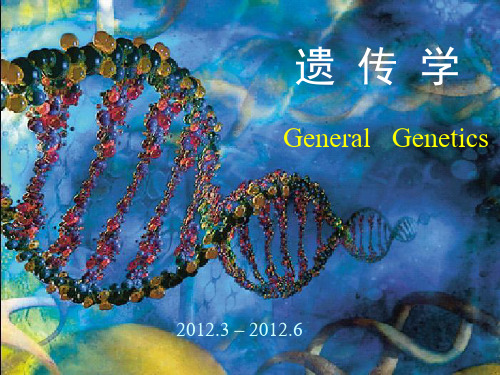1.1 遗传的细胞与分子基础 英文版
生物科学专业英语第一课

Organelles are suspended within it, supported by the filamentous network of the cytoskeleton.
Dissolved in the cytoplasmic fluid are nutrients, ions, soluble proteins, and other materials needed for cell functioning.
found in the flagella and microtubules of eukaryotic cells and possessing ATPase activity.
Myosin 肌球蛋白 A protein that, with actin, constitutes the
principal element of the contractile apparatus of muscle.
Nuclear envelope 核膜,核被膜 A double membrane (two lipid bilayers
and associated proteins) that is the outermost portion of a cell nucleous. Nucleoid 核质体 The DNA-containing area of a prokaryote cell, analogous to eukaryote nucleus but not membrane bounded.
Stroma 子座,基质
Region within a chloroplast that has no chlorophyll.
Plastid 质体
02.遗传的细胞和分子基础

同拷贝的基因产物在氨基酸的组成上存在差异。
四川医科大学 医学生物学与遗传学教研室
(二)重复序列 高度重复序列
由很短的碱基序列重复而成,长度 2 ~ 200 bp,重复次数106~108。
高度重复顺序不转录,功能主要是参与染
色体结构的维持、形成结构基因的间隔并 可能在减数分裂过程中同染色体的联会有 关。
核型分析
四川医科大学 医学生物学与遗传学教研室
显带染色体
四川医科大学 医学生物学与遗传学教研室
显带染色体
带的描述: ①染色体号 ②臂的符号 长臂q;短臂p ③区的序号 ④带的序号 例如:1q42 高分辨显带 : ①②③④ ⑤亚带 ⑥次亚带 例如:1q42.11
四川医科大学 医学生物学与遗传学教研室
四川医科大学 医学生物学与遗传学教研室
四、人类的性别决定机制
性染色体学说
性染色体在性别决定中起决定作用
两条性染色体形态、结构和大小均有明显差别 女性核型为XX,男性核型为XY(XY型性别决定)
男性决定后代性别
基因决定性别
Y染色体 TDF:testis-determining factor SRY:sex-determining region of Y chromosome
四川医科大学 医学生物学与遗传学教研室
染色质的超微结构与组装 :
分子生物学英文原版

分子生物学英文原版Molecular Biology English Original is an essential reference book for students and researchers who areinterested in the study of molecular biology. It provides a detailed exploration of molecular biology research and discoveries, and serves as a comprehensive guide to different techniques and methodologies used in the field. In this article, we will discuss the book in detail, step by step.Step 1: Overview of the BookThe book starts with an introduction to molecular biology and an overview of the key concepts and principles involved. It provides a history of molecular biology research and the key discoveries that led to the development of the field. The book then goes on to cover different topics such as DNA replication, transcription, translation, gene regulation, and genetic engineering.Step 2: Understanding the ConceptsThe book explains the concepts and theories of molecular biology in a clear and concise manner. It provides detailed explanations of different techniques and methodologies usedin molecular biology research, including DNA sequencing, PCR, gel electrophoresis, gene cloning, and protein purification. It also includes detailed walkthroughs of various experiments and provides step-by-step procedures for performing them.Step 3: Real-life ApplicationsThe book provides real-life applications of molecular biology research and technologies. It describes how molecular biology has revolutionized medical science, plant science,and bioengineering. It discusses the use of molecular biology techniques in disease diagnosis, gene therapy, and drug development. It also talks about how molecular biology isused to engineer crops with desirable traits and to develop new pharmaceuticals.Step 4: Future DevelopmentsThe book ends with a discussion of future developmentsin molecular biology research. It highlights the potentialuse of CRISPR-Cas9 gene editing technology, which has revolutionized gene editing and holds great promise for the treatment of genetic diseases. It also discusses the use of molecular biology in the development of personalized medicine, where treatments are tailored to an individual's genetic makeup.In Conclusion, Molecular Biology English Original is an indispensable resource for students and researchers in thefield of molecular biology. It provides a comprehensive overview of molecular biology research and discoveries, and serves as a guide to different techniques and methodologies used in the field. The book is an excellent reference toolfor those interested in the real-world applications of molecular biology and its future developments.。
精选遗传的细胞基础资料

① 非组蛋白是一类酸性蛋白质,含天门冬氨酸, 谷氨酸等酸性氨基酸,带负电荷。 ② 非组蛋白数量少但是种类多 。 ③ 非组蛋白是真核细胞转录调控因子,与基因 的选择性表达有关;非组蛋白可以被磷酸化,是 基因表达调控的重要环节。
Chapter 2
一、染色质的化学组成
Chapter 2
二、人类正常核型
(二)染色体显带技术
1、Q 显带(Q banding) 2、G 显带(G banding) 3、R 显带(R banding) 4、T 显带(T banding) 5、C 显带(C banding) 6、N 显带(N banding)
Chapter 2
Chapter 2
Chapter 2
小结
Chapter 2
• 掌握:
• 染色体形态结构;人类的正常核型(Denver 体制);G显带染色体的识别与命名;人类性 别决定;
复习思考题
Chapter 2
一、名词解释 1.核小体(nucleosome) 2.核型(karyotype) 二、问答题
常染色质与异染色质在结构和功能 上有何差异?
Chapter 2
Chapter 2
Chapter 2
人类的染色体显带核型
• Q带:氮芥喹吖因(QM) • G带:胰酶+Giemsa • R带:经处理的标本+Giemsa or Acridine Orange • T带:染色体末端结构异常
Chapter 2
Chapter 2
人类的染色体显带核型
Chapter 2
一、染色质的化学组成
1、DNA 2、组蛋白 ① 组蛋白是构成染色质的主要蛋白质成分,
富含精氨酸和赖氨酸带正电荷的碱性蛋白。 ② 可分为H1、H2A、H2B、H3和H4五类。 ③ 生物体可以通过调控组蛋白的化学修饰, 达到调控遗传信息转录的目的。
第一章 遗传的细胞学基础资料

Short arm
Long arm
2020/11/1 23
2020/11/1 24
3 次缢痕(secondary constriction)与随体(satellite)
●次缢痕:通常在染色体短臂上。次缢痕的末端的 圆形或略长形的突出体,称为随体。
●次缢痕在细胞分裂时紧密 地与核仁相联系。与核仁的 形成有关—核仁组织中心 (nucleolus organizer region, NOR)。
1、细胞组成:
细胞壁:蛋白聚糖; 细胞膜: 细胞质:核糖体等;无膜胞器 拟核区:DNA、RNA等;
2、原核生物:
各种细菌、蓝藻等低等生物,由原核细胞
构成,统称为原核生物(prokaryote)。
2020/11/1 5
二、真核细胞
细胞壁
内质网 线粒体
真核 生物
→细胞
质膜(细胞膜)
叶绿体 高尔基体
细胞质 液泡 溶酶体
2020/11/1 14
一、染色体的形态特征
●真核生物染色体是以DNA与碱性蛋白质结合 的形式存在。
●原核生物染色体是以DNA裸露的形式存在。
2020/11/1 15
(一) chromatin and chromosome
❖ 染色质(包括常染色质和异染色质):细胞分裂间期 核内,对碱性染料着色均匀的网状、丝状的物质。
•细胞分裂与生物生长发育 及繁殖行为。包括细胞有 丝分裂、减数分裂、配子 (体)形成以及细胞(配子)融 合过程及其机制
2020/11/1
•细胞核的结构与功能及染 色体的形态、结构和数目;
•细胞有丝分裂、减数分裂、 两性细胞融合(受精)的过程 及其染色体的行为变化;
繁殖和遗传的细胞基础 大学生物 The Cellular Basis of Reproduction and Inheritance

Classfication
• Two main type
1. Asexual reproduction
Binary fission
Int J Dev Biol. 2012;56(1-3):173-82.
Budding Sporห้องสมุดไป่ตู้ formation Vegetative reproduction Fragmentation Parthenogenesis
2. Sexual reproduction
Zoolog Sci. 2012 Apr;29(4):265-72.
5. The production of gametes -egg and sperm -involves a special type of cell division that occurs only in reproduction organs (such as tests and ovaries in human). 6. Offspring produced by sexual reproduction, generally resemble their parents but they are not identical to their parents or to each other, can produce great variation among offspring. 7. After an organism is fully grown, cell division continues to function in renewal and repair, replacing cells that die from normal wear and tear or accidents. 8. The type of cell division responsible for asexual reproduction and for the growth and maintenance of multicellular organisms involves a process called mitosis.
遗传的分子与细胞基础

1.6.基因突变与修复
1.6.1.基因突变
1.6.1.2.基因突变类型 1.6.1.2.2.移码突变
UAC AGU CCU ACA GAA UGG GAG Tyr Ser Pro Thr Glu Trp Glu
UAC AAG UCC UAC AGA AUG GGA G Tyr Lys Ser Tyr Arg Met Gly
人类正常体细胞有46条染色体(2n=46),其
中22对为常染色体(autosome),1对为性染色体
(sex chromosome 或heterochromosome)。男性
的性染色体是XY,女性是XX。正常生殖细胞
(配子)中有23条染色体(n=23)。
2.3.人类的正常核型
2.3.1.人类染色体非显带核型
1.6.2.DNA的修复
DNA 复制过程中出现的差错,或者受各种内 外不利环境因素所造成的 DNA损伤,通过 DNA修 复系统能得到修复,正因为如此,进一步保证了 DNA的稳定性。
光修复 切除修复 复制后修复
生命的遗传与变异
核酸内切酶先在 嘧啶二聚体附近切开 DNA单链,然后以另 一条正常链为模板, 按碱基互补原则补齐 需切除部分的碱基序 列,最后由核酸外切 酶切去含嘧啶二聚体 的片段,并由连接酶 将断口与新合成的 DNA片段连接起来。
同义突变(same sense mutation)
AUG CAU UCC „„ AGA AUU UAA AAG Met His Ser „„ Arg Ile # AUG CAU UCC „„ AGG AUU UAA AAG Met His Ser „„ Arg Ile #
生命的遗传与变异
1.6.基因突变与修复
专业英语遗传学的基础

Dominant and recessive genes: In Mendelian inheritance, there is a distinction between dominant and recessive genes. Dominant genes can express their characteristics, while recessive genes are only expressed when there are no dominant genes present.
02
Genetic material foundation
Discovery
DNA was first isolated from white blood cells in 1869 by Friedrich Miesecher However, its significance was not realized until the 1950s when Watson and Crick proposed its double helix structure
Heterozygous and homozygous: Heterozygous individuals refer to individuals with one dominant gene and one recessive gene in an allele, while homozygous individuals refer to individuals with the same genotype in all alleles.
第1章遗传的细胞学基础-文档资料

• 但是,在性器官中发生
单倍体无融合生殖
• 又称单性生殖。 • 减数分裂产物未经受精直接发育成胚(n)。
• 孤雌生殖 • 孤雄生殖 • 无配子生殖
• 花粉培养
二倍体无融合生殖
• 胚囊中的细胞不经过减数分裂直接发育 成胚。
不定胚
• 体细胞直接发育成胚。 • 多是珠心、珠被或其邻近的细胞。
核膜 nuclear membrane 核浆 nuclear sap 核仁 nucleolus 染色质chromatin和染色体chromosome
第2节 染色体
染色质
• 染色质chromatin:间期细胞核内能被碱 性染料着色的物质。
• 组成:DNA、组蛋白、非组蛋白、RNA
• 染色质丝:10nm,含有一条DNA分子
3、同源染色体在前期I联会,非姊妹染色 单体发生交换。
减数分裂的遗传学意义
染色体数减半,保证了亲子代间染色体数目 的恒定性,保证了物种的相对稳定性。
为生物的变异提供了重要的遗传物质基础, 有利于生物的适应和进化,并为人工选择提 供了丰富的材料。
后期I同源染色体的两个成员随机分向两极,各 个非同源染色体可以自由组合在一个子细胞中。
• 为研究方便起见,分为:
• 前期 prophase • 中期 metaphase • 后期 anaphase • 末期 telophase
Mitosis
有丝分裂的遗传学意义
• 子代细胞核精确地含有和亲代细胞核完 全相同的遗传物质。
• 这种均亲分裂的方式,保证了遗传物质 在同一世代内稳定存在和传递。
被子植物的双受精
• 1898年俄国科学家纳瓦兴发现了被子植物 的双受精现象 double fertilization。
遗传的细胞学及分子基础文稿演示

遗传与变异是矛盾对立统一的两个方面
遗传是相对的、保守的,没有遗传就没有物种的 相对稳定,也就不存在变异的问题
而变异是绝对的、发展的;没有变异生物就不会 产生新的性状,也就不能发展、进化
遗传、变异和选择是生物进化和新品种选育 的三大因素
变异
创造变异
自然选择
异染色质在细胞分裂间期,染色质线仍高度螺旋 化而紧密卷缩。
常染色质在细胞分裂间期,染色质线脱螺旋而呈 松散状态。
❖功能差异
➢常染色质间期活跃表达,带有重要的遗传信息。 ➢异染色质在遗传功能上是惰性的,一般不编码蛋 白质,主要起维持染色体结构完整性的作用。
❖组成性与兼性异染色质
组成性异染色质 (constitutive heterochromatin):
1972年,距离印度苏尔坦普尔20英里的穆萨法哈 纳森林中被发现,当时4岁,取名沙姆迪欧。
3.遗传学(genetics):
是研究生物遗传和变异的 科学。
研究各种生物遗传信息的传 递及遗传信息如何决定生物的 性状与发育的。
▪ 遗传学的研究任务
阐明:生物遗传和变异现象→表现规律;
探索:遗传和变异原因→
中间着丝点染色体
近中着丝点染色体
近端着丝点染色体
端着丝点染色体
粒状染色体
染色体的形态类型
染色体类型
符号
臂比①
着丝粒 指数②
后期形态
中间着丝点染色体
M
1.00-1.6ic cs
近中着丝点染色体
Sub-metacentric cs
SM
1.68-3.00
0.374-0.250
物质基础→内在规律;
指导:动物、植物和微生物
遗传学-2遗传的细胞基础

可编辑版
9
可编辑版
10
第二章 遗传的细胞学基础
细胞(cell)是生物体结构和生命活动的基本单位。生 物界除了病毒和噬菌体等最简单的生物外,所有的植物和 动物,不论低等的还是高等的,都是由细胞构成的。
在生物的生命活动中,繁殖后代是一个重要的基本特征。
无性繁殖 一系列的细胞分裂
有性繁殖
繁衍后代
因此,为了深入研究生物遗传和变异的规律及其内在 机理,有必要对细胞的结构和功能、细胞的分裂方式、以 及生物繁殖方式与遗传表现的关系进行介绍。
量很多。它是蛋白质合成的主要场所。
核糖体是由大约40%的蛋白质和60%的RNA所组成, 其中RNA主要是核糖体核糖核酸(rRNA),故亦称为核糖 蛋白体。
核糖体可以游离在细胞质中或核里,也可以附着在 内质网上。在线粒体和叶绿体中也都含有核糖体。
可编辑版
动画(核糖体)
26
D 内质网 是在真核细胞质中广泛分布的膜相结构。把质膜和
核膜连成一个完整的膜体系,为细胞空间提供了支架作 用。
内质网是单层膜结构。它在形态上是多型的,不仅 有管状,也有一些呈囊腔状或小泡状。
粗糙内质网(附有核糖体的内质网),是蛋白质合成的 主要场所。
平滑型内质网(不附着核糖体的内质网),可能与某些 激素合成有关。图(内质网)。
可编辑版
27
内质网
可编辑版
可编辑版
18
植物细胞不同于动物细胞,在其细胞质膜的外围 有一层由纤维素和果胶质等构成的细胞壁,对植物细 胞和植物体起保护和支持作用。细胞壁上有许多微孔 称胞间连丝,是相邻细胞间的通道,导致相邻细胞的 原生质的连续,有利于细胞间的物质转运 。
图(胞间连丝)
可编辑版
2遗传的细胞学基础101

5、染色体组型和组型分析
染色体组型(核型)(karyotype) 指一个个体或一组相关个体特有的染色体
组,通常以有丝分裂中期染色体的数目和形态 来表示。 染色体组型(核型)分析(karyotype analysis)
按照染色体的数目、大小和着丝粒位置、 臂比、次缢痕、随体等形态特征,对生物体内 的染色体进行配对、分组、归类、编号、进行 分析的过程称为染色体组型分析或核型分析。
形态结构上有所不同的染色体间互称为非 同源染色体。
23
24
染色体的大小
⑴ 各物种差异很大,同一物种染色体宽度大致相 同。 植物: 长约 0.20 - 50 μm、 宽约 0.20 - 2.00 μm。
⑵ 高等植物中单子叶植物的染色体一般比双子 叶植物要大些。 单子叶植物中: 玉米、小麦、大麦和黑麦> 水稻。 但双子叶植物中的牡丹属和鬼臼属也具有较大 的染色体。
细胞周期 从上一次细胞分裂结束到下一次细胞分裂结
束所经历的过程称为一个细胞周期。
可分为:
间期: G1,S,G2
分裂期: 前、中、后、末
42
S phase = chromosomes are duplicated
43
2、有丝分裂的过程
两个过程:细胞核分裂,细胞质分裂 核分裂分为四个时期:
前期(prophase) 中期(metaphase) 后期(anaphase) 末期(telophase)
中期(metaphase) 核仁和核膜消失 各个染色体的着丝 点均排列在纺锤体 中央的赤道面
48
⑴、细胞核分裂
后期(anaphase) 着丝点分裂,各条 染色单体各成为一 个染色体。 随着纺锤丝的牵引 每个染色体分别向 两极移动
- 1、下载文档前请自行甄别文档内容的完整性,平台不提供额外的编辑、内容补充、找答案等附加服务。
- 2、"仅部分预览"的文档,不可在线预览部分如存在完整性等问题,可反馈申请退款(可完整预览的文档不适用该条件!)。
- 3、如文档侵犯您的权益,请联系客服反馈,我们会尽快为您处理(人工客服工作时间:9:00-18:30)。
(5) In prokaryotes, the DNA loop replicates before fission ( 分裂), with both loops still attached to the cell membrane.
• Prokaryotes lack a defined nucleus and have a simplified internal structure
(细菌)
• Eukaryotes have membrane limited nucleus and more complicated internal structure
• Three branches of life
(真核生物界)
(ell
Prokaryotes: which include the archaea (古细菌) and bacteria, are the simplest, oldest, and most common organisms on the planet.
(3) Prokaryotes do not have sexual reproduction, though they have several forms of gene exchange.
These include swapping (交换的) plasmids (质粒).
(4) The various genes, about 1200 in a typical bacterium, are arranged along the length of the chromosome, like beads on a string.
(3) Eukaryote DNA (except plastid 质体DNA, which is very similar to bacterial DNA because of its evolutionary origin) is usually linear, not circular.
The cellular and molecular basis in Genetics
The Cell
• Basic component of life
• Two main categories,
prokarytic
and
eukaryotic cells
• Differences in the nucleus
During fission, as the cell membrane splits in two, one loop of DNA ends up in each new “daughter cell”
Animal cell
Plant cell
This is the basic structure of all living things. Animals, plants, and to some extent even bacteria (they are made up of cells too, but the cells have a different structure,). The mitochondria (as well as chloroplasts in plants) are thought to be ancient bacteria that were somehow swallowed by the cell, and these mitochondria (including chloroplasts) carry some DNA of their own, but it’s the DNA in the nucleus of the cell we’ll be focusing on.
(1) A typical prokaryote has a much smaller genome than a typical eukaryote.
Nearly always, it is in the form of a simple loop of DNA.
This loop is attached to the cell membrane.
(2) Like prokaryotes, eukaryote genes are arranged along the length of a chromosome like beads on a string.
There is no particular functional reason for their location, either within a chromosome, or with respect to what chromosome they are on, it is mostly an evolutionary accident.
Eukaryotes:
-including plants, animals, fungi, protists (原生生物), often multicellular.
(1) Most eukaryotes have several orders of magnitude more DNA than a typical prokaryote. DNA is contained within a membrane-bound nucleus.
(2) Even though the structure simple, there is a lot of DNA in a single bacterium.
Stretched out, the DNA in an E. coli would be 500 times longer than the cell itself.
